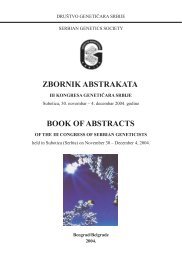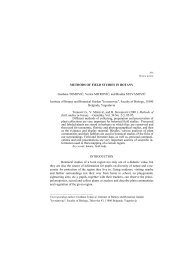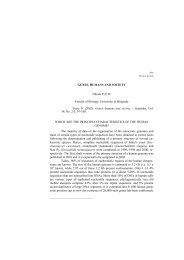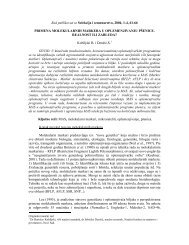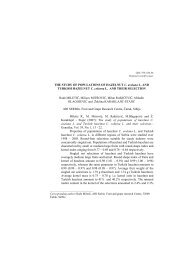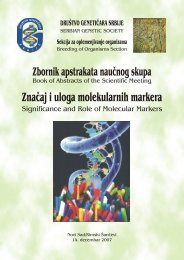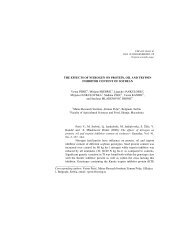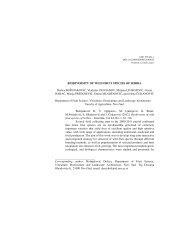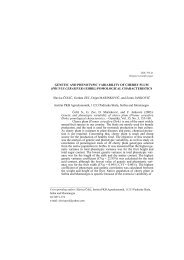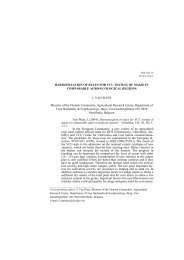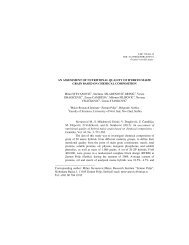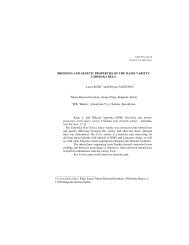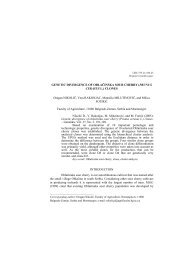Initial and final fruit set in some plum (Prunus domestica L.) hybrids ...
Initial and final fruit set in some plum (Prunus domestica L.) hybrids ...
Initial and final fruit set in some plum (Prunus domestica L.) hybrids ...
Create successful ePaper yourself
Turn your PDF publications into a flip-book with our unique Google optimized e-Paper software.
UDC 575:630<br />
DOI: 10.2298/GENSR1203583G<br />
Orig<strong>in</strong>al scientific paper<br />
INITIAL AND FINAL FRUIT SET IN SOME PLUM (<strong>Prunus</strong> <strong>domestica</strong> L.)<br />
HYBRIDS UNDER DIFFERENT POLLINATION TYPES<br />
Ivana GLIŠIĆ, Radosav CEROVIĆ, Nebojša MILOŠEVIĆ,<br />
Milena ĐORĐEVIĆ <strong>and</strong> Sanja RADIČEVIĆ<br />
Fruit Research Institute, Kralja Petra I 9, 32000 Čačak, Serbia<br />
Glišić I., R. Cerović, N. Milošević, M.Đorđević, <strong>and</strong> S. Radičević<br />
(2012): <strong>Initial</strong> <strong>and</strong> <strong>f<strong>in</strong>al</strong> <strong>fruit</strong> <strong>set</strong> <strong>in</strong> <strong>some</strong> <strong>plum</strong> (prunus <strong>domestica</strong> L.)<br />
<strong>hybrids</strong> under different poll<strong>in</strong>ation types. - Genetika, Vol 44, No. 3, 583-<br />
593.<br />
The paper presents results of two-year study (2009–2010) of <strong>in</strong>itial<br />
<strong>and</strong> <strong>f<strong>in</strong>al</strong> <strong>fruit</strong> <strong>set</strong> <strong>in</strong> promis<strong>in</strong>g <strong>plum</strong> (<strong>Prunus</strong> <strong>domestica</strong> L.) <strong>hybrids</strong><br />
developed at Fruit Research Institute – Čačak, under different poll<strong>in</strong>ation<br />
conditions. The follow<strong>in</strong>g <strong>hybrids</strong> were studied: 38/62/70 (‘Hall’ x<br />
‘California Blue’), 32/21/87 (‘Stanley’ x ‘Scoldus’), IV/63/81 (‘Large<br />
Sugar Prune’ x ‘Scoldus’), 22/17/87 (‘Čačanska Najbolja’ x ‘Zh'lta<br />
Butilcovidna’), 29/29/87 (‘Stanley’ x ‘Scoldus’) <strong>and</strong> 34/41/87 (‘Valjevka’ x<br />
‘Čačanska Lepotica’). Each of the <strong>hybrids</strong> was studied both under selfpoll<strong>in</strong>ation<br />
<strong>and</strong> open poll<strong>in</strong>ation. In vitro pollen germ<strong>in</strong>ation was also<br />
performed as well as characteristics of flower<strong>in</strong>g phenophase <strong>and</strong> flower<strong>in</strong>g<br />
____________________________<br />
Correspond<strong>in</strong>g author: Ivana Glišić, Fruit Research Institute, Kralja Petra I 9,<br />
32000 Čačak, Serbia, Phone: 032/221-375, Fax: 032/221-391,<br />
E-mail: glisiciva2004@yahoo.com
584 GENETIKA, Vol. 44, No.3, 583-593, 2012<br />
abundance. Generally, the results suggest lower flower<strong>in</strong>g abundance <strong>in</strong> the<br />
second year of the study. Pollen germ<strong>in</strong>ation ranged from averagely 25.31%<br />
(29/29/87) to 40.01% (38/62/70). With averagely 31.59% <strong>f<strong>in</strong>al</strong> <strong>fruit</strong> <strong>set</strong><br />
under self-poll<strong>in</strong>ation <strong>and</strong> 29.38% under open poll<strong>in</strong>ation variants,<br />
respectively, hybrid 34/41/87 gave the best results. The lowest performance<br />
was observed <strong>in</strong> hybrid 32/21/87 with 1.61% <strong>and</strong> 7.69% <strong>f<strong>in</strong>al</strong> <strong>fruit</strong> <strong>set</strong> under<br />
self- <strong>and</strong> open poll<strong>in</strong>ation variants, respectively.<br />
Key words: flower<strong>in</strong>g, <strong>fruit</strong> <strong>set</strong>, <strong>plum</strong>, pollen, promis<strong>in</strong>g <strong>hybrids</strong><br />
INTRODUCTION<br />
Plum is an important <strong>fruit</strong> species, <strong>in</strong>terest<strong>in</strong>g for various forms of <strong>in</strong>dustrial<br />
<strong>and</strong> domestic process<strong>in</strong>g, <strong>and</strong> for fresh consumption. Grown on the area of 135,632<br />
ha <strong>and</strong> with an average annual production of 419,813 t (over 2000–2007, FAO<br />
Statistic Division, 2009), European <strong>plum</strong> (<strong>Prunus</strong> <strong>domestica</strong> L.) is a lead<strong>in</strong>g <strong>fruit</strong><br />
species <strong>in</strong> Serbia (MRATINIĆ et al., 2006), provid<strong>in</strong>g Serbia the fourth rank<strong>in</strong>g <strong>in</strong> total<br />
production on global scale (MILOŠEVIĆ et al., 2010).<br />
Plum belongs to Rosaceae family, Prunoideae subfamily, <strong>and</strong> Prunophora<br />
subgenus which <strong>in</strong>cludes a number of different species of <strong>Prunus</strong> genus. The bestknown<br />
<strong>and</strong> most widely grown species are <strong>Prunus</strong> <strong>domestica</strong> L., <strong>Prunus</strong> salic<strong>in</strong>a<br />
L<strong>in</strong>dl., <strong>Prunus</strong> subcordiata Benth. <strong>and</strong> <strong>Prunus</strong> <strong>in</strong>stititia L. (VOĆA et al, 2009).<br />
European <strong>plum</strong> (<strong>Prunus</strong> <strong>domestica</strong> L.) is a hexaploid <strong>fruit</strong> species (2n=6x=48),<br />
orig<strong>in</strong>at<strong>in</strong>g from natural cross<strong>in</strong>g of <strong>Prunus</strong> sp<strong>in</strong>osa (4x) <strong>and</strong> <strong>Prunus</strong> cerasifera (2x)<br />
genera (DECROOCQ et al., 2004; ILGIN et al., 2009).<br />
Self-fertility, ability to <strong>set</strong> <strong>fruit</strong> follow<strong>in</strong>g self-poll<strong>in</strong>ation, is an important<br />
trait <strong>in</strong> many <strong>Prunus</strong> species that contributes to higher, more consistent yields. Most<br />
<strong>Prunus</strong> <strong>fruit</strong> tree species exhibit a homomorphic gametophytic self-<strong>in</strong>compatibility<br />
(GSI) system, <strong>in</strong> which specificity of self/nonself-recognition is controlled by<br />
products encoded with<strong>in</strong> the S locus; <strong>in</strong> the poll<strong>in</strong>ation event, a self-<strong>in</strong>compatibility<br />
(SI) reaction is triggered when the same S allele specificity is expressed <strong>in</strong> both the<br />
pollen <strong>and</strong> pistil (TAO <strong>and</strong> IEZZONI, 2010). Dur<strong>in</strong>g the last two decades, much<br />
progress has been made <strong>in</strong> underst<strong>and</strong><strong>in</strong>g of the molecular basis of the gametophytic<br />
self-<strong>in</strong>compatibility system <strong>in</strong> <strong>Prunus</strong> species – sweet <strong>and</strong> sour cherry, almond,<br />
apricot, <strong>and</strong> <strong>plum</strong>. While diploid <strong>plum</strong> types are ma<strong>in</strong>ly self-<strong>in</strong>compatible, fertility<br />
level of European <strong>plum</strong> varies between self-fertility, partial self-fertility <strong>and</strong> self<strong>in</strong>compatibility<br />
(SZABÓ, 2003). In this l<strong>in</strong>e, the important factor for successful <strong>plum</strong><br />
grow<strong>in</strong>g is ga<strong>in</strong><strong>in</strong>g knowledge on a degree of self-fertility of a cultivar (NIKOLIĆ <strong>and</strong><br />
MILATOVIĆ, 2010). HEGEDUS <strong>and</strong> HALASZ (2006) report that almost half the total<br />
number of cultivars with<strong>in</strong> this species are self-sterile.<br />
On the other h<strong>and</strong>, knowledge of flower<strong>in</strong>g time of <strong>plum</strong> cultivars is<br />
essential for an adequate choice of cultivar comb<strong>in</strong>ation that ensures the most<br />
effective poll<strong>in</strong>ation <strong>and</strong> fertilization for abundant <strong>fruit</strong> <strong>set</strong>. Successful poll<strong>in</strong>ation<br />
<strong>and</strong> fertilization is one of the most important factors affect<strong>in</strong>g the f<strong>in</strong>ancial outcome<br />
<strong>in</strong> commercial <strong>fruit</strong> grow<strong>in</strong>g (KOSKELA et al., 2010).
I. GLISIC et al.: FRUIT SET IN PROMISING PLUM HYBRIDS 585<br />
Plum breed<strong>in</strong>g work at Fruit Research Institute was <strong>in</strong>itiated <strong>in</strong> 1946 s<strong>in</strong>ce<br />
when 14 <strong>plum</strong> cultivars have been developed with<strong>in</strong> different breed<strong>in</strong>g programs,<br />
with a large number of promis<strong>in</strong>g <strong>hybrids</strong> currently be<strong>in</strong>g evaluated (PAUNOVIĆ et<br />
al., 2011). Self-fertility of the new genotype is one of the breed<strong>in</strong>g objectives of<br />
<strong>plum</strong> breed<strong>in</strong>g work (MILENKOVIĆ et al., 2006).<br />
The aim of this paper was to exam<strong>in</strong>e the degree of the <strong>in</strong>itial <strong>and</strong> <strong>f<strong>in</strong>al</strong> <strong>fruit</strong><br />
<strong>set</strong> <strong>in</strong> self- <strong>and</strong> open poll<strong>in</strong>ation variants <strong>in</strong> six promis<strong>in</strong>g <strong>plum</strong> <strong>hybrids</strong> developed at<br />
Fruit Research Institute – Čačak, <strong>in</strong> order to obta<strong>in</strong> data of <strong>in</strong>terest for <strong>plum</strong> orchard<br />
establish<strong>in</strong>g, further <strong>in</strong>vestigation of reproductive biology of European <strong>plum</strong>, <strong>and</strong><br />
breed<strong>in</strong>g work.<br />
MATERIALS AND METHODS<br />
Plant material<br />
The experiment <strong>in</strong>cluded six promis<strong>in</strong>g <strong>plum</strong> (<strong>Prunus</strong> <strong>domestica</strong> L.)<br />
<strong>hybrids</strong>, developed at Fruit Research Institute – Čačak: 38/62/70 (‘Hall’ x ‘California<br />
Blue’), IV/63/81 (‘Large Sugar Prune’ x ‘Scoldus’), 32/21/87 (‘Stanley’ x<br />
‘Scoldus’), 22/17/87 (‘Čačanska Najbolja’ x ‘Zh'lta Butilcovidna’), 29/29/87<br />
(‘Stanley’ x ‘Scoldus’) <strong>and</strong> 34/41/87 (‘Valjevka’ x ‘Čačanska Lepotica’).<br />
Experiment conducted over 2009–2010 <strong>in</strong> the experimental orchard at the Ljubić site<br />
of Fruit Research Institute, Čačak (altitude of 260 m). The orchard was established <strong>in</strong><br />
autumn 2002 with st<strong>and</strong>ard one-year-old plants grafted on Myrobalan (<strong>Prunus</strong><br />
cerasifera L.) seedl<strong>in</strong>gs, planted at 6 x 5 m (333 trees per ha). The tra<strong>in</strong><strong>in</strong>g system is<br />
open vase. Conventional cultural practices were applied <strong>in</strong> the plant<strong>in</strong>g.<br />
Flower<strong>in</strong>g time <strong>in</strong>vestigation<br />
To <strong>in</strong>vestigate the flower<strong>in</strong>g phenophase, flower<strong>in</strong>g time, progress <strong>and</strong><br />
abundance of flower<strong>in</strong>g were studied. Monitor<strong>in</strong>g <strong>and</strong> tak<strong>in</strong>g notes on flower<strong>in</strong>g<br />
on<strong>set</strong> (10–20% open flowers); full flower<strong>in</strong>g (80–100% open flowers); end of<br />
flower<strong>in</strong>g (fallen over 90% petals) were done. Abundance of flower<strong>in</strong>g is expressed<br />
on scale 0–5: excellent (5), very good (4), good (3), poor (2), very poor (1) <strong>and</strong> no<br />
flowers (0).<br />
Pollen germ<strong>in</strong>ation test<br />
For exam<strong>in</strong>ation of pollen viability, <strong>in</strong> vitro pollen germ<strong>in</strong>ation test was<br />
used. The test <strong>in</strong>volved collect<strong>in</strong>g branches with buds <strong>in</strong> late balloon stage. Anthers<br />
of each hybrid were separated from flowers <strong>in</strong> laboratory, placed <strong>in</strong>to paper boxes<br />
<strong>and</strong> dried at 20ºC for 24–28 h until crack<strong>in</strong>g <strong>and</strong> pollen dust<strong>in</strong>g. Pollen of each<br />
hybrid was grown <strong>in</strong> the three Petri dishes, <strong>in</strong> the <strong>in</strong> vitro medium conta<strong>in</strong><strong>in</strong>g 12%<br />
sucrose <strong>and</strong> 1% agar (CEROVIĆ et al., 2003) <strong>and</strong> ma<strong>in</strong>ta<strong>in</strong>ed at 24°C for 24 hours.<br />
Flowers, anthers <strong>and</strong> pollen were carefully manipulated to avoid any contam<strong>in</strong>ation<br />
of samples by pollen. Three visual fields of each Petri dish were monitored under<br />
OLIMPUS BX61 microscope (light regime); the visual field <strong>in</strong>cluded about 100
586 GENETIKA, Vol. 44, No.3, 583-593, 2012<br />
pollen gra<strong>in</strong>s. As germ<strong>in</strong>ated, pollen gra<strong>in</strong>s with pollen tubes length of twice of the<br />
gra<strong>in</strong> diameter were counted.<br />
<strong>Initial</strong> <strong>and</strong> <strong>f<strong>in</strong>al</strong> <strong>fruit</strong> <strong>set</strong> <strong>in</strong>vestigation<br />
Emasculation of flowers was done at late balloon stage, by remov<strong>in</strong>g the<br />
perianths <strong>and</strong> anthers. Emasculated flowers were counted, <strong>and</strong> isolated with paper<br />
bags <strong>in</strong> order to prevent uncontrolled poll<strong>in</strong>ation. At the beg<strong>in</strong>n<strong>in</strong>g of full flower<strong>in</strong>g,<br />
they manually poll<strong>in</strong>ated with their own pollen (prepared as described above), <strong>and</strong><br />
isolated once more with the bags; the bags removed two weeks after poll<strong>in</strong>ation. 300<br />
flowers of each hybrid were poll<strong>in</strong>ated per year of the study. Also, branches were<br />
marked <strong>and</strong> flowers counted on the same day (late balloon stage) to exam<strong>in</strong>e <strong>fruit</strong> <strong>set</strong><br />
<strong>in</strong> open-poll<strong>in</strong>ation variant (300 flowers of each hybrid). <strong>Initial</strong> <strong>fruit</strong> <strong>set</strong> was<br />
monitored by count<strong>in</strong>g <strong>fruit</strong>s 3–4 weeks after the poll<strong>in</strong>ation, while the <strong>f<strong>in</strong>al</strong> <strong>fruit</strong> <strong>set</strong><br />
was checked at the beg<strong>in</strong>n<strong>in</strong>g of <strong>fruit</strong> ripen<strong>in</strong>g phenophase.<br />
Statistical analysis<br />
A completely r<strong>and</strong>omized block system with five trees <strong>in</strong> three replications<br />
was used. The data were statistically analyzed us<strong>in</strong>g the analysis of variance model<br />
(ANOVA). The significance of differences among mean values was determ<strong>in</strong>ed<br />
us<strong>in</strong>g LSD test at P
I. GLISIC et al.: FRUIT SET IN PROMISING PLUM HYBRIDS 587<br />
<strong>plum</strong> cultivar such as ‘Čačanska Lepotica’, ‘Stanley’, ‘Mildora’ <strong>and</strong> ‘Ana Spat’<br />
(BOTU et al., 2002; OGAŠANOVIĆ et al., 2005; DRAGOYSKI et al., 2005). Most of<br />
European <strong>plum</strong> genotypes flower at the approximately same time, provid<strong>in</strong>g an<br />
adequate flower<strong>in</strong>g overlap for effective cross-poll<strong>in</strong>ation among them. In a warm<br />
spr<strong>in</strong>g, the total flower<strong>in</strong>g period will be shortened, <strong>and</strong> many genotypes may<br />
overlap, result<strong>in</strong>g <strong>in</strong> effective cross-poll<strong>in</strong>ation, while <strong>in</strong> a cold spr<strong>in</strong>g, the whole<br />
flower<strong>in</strong>g period is lengthened, <strong>and</strong> less overlapp<strong>in</strong>g will occur. However, <strong>in</strong> order to<br />
perform the classification of promis<strong>in</strong>g <strong>hybrids</strong>, it is necessary to perform<br />
phenological observations over a longer period.<br />
Graph.1. Phenophase of flower<strong>in</strong>g <strong>in</strong> studied <strong>plum</strong> <strong>hybrids</strong><br />
Abundance of flower<strong>in</strong>g (Graph. 2) ranged from an average of 2.75 (hybrid<br />
29/29/87) to 5 (hybrid 22/17/87) <strong>and</strong> was more uniform <strong>in</strong> the first experimental<br />
year, when, with the exception of hybrid 29/29/87, all <strong>hybrids</strong> showed maximum<br />
yield potential. In the second year of study, slightly lower abundance of flower<strong>in</strong>g<br />
was observed <strong>in</strong> <strong>hybrids</strong>, with the exception of 22/17/87, which ma<strong>in</strong>ta<strong>in</strong>ed the<br />
abundance level ga<strong>in</strong>ed <strong>in</strong> the previous year.<br />
Also, <strong>in</strong> terms of abundance of flower<strong>in</strong>g, the <strong>hybrids</strong> do not lag beh<strong>in</strong>d<br />
commercial <strong>plum</strong> cultivars characterized by high productivity (SOSNA, 2010; GLIŠIĆ<br />
et al., 2011). High abundance of flower<strong>in</strong>g of studied <strong>hybrids</strong> can be partially<br />
expla<strong>in</strong>ed by good donor ability for high yield of parental cultivars ‘Stanley’ <strong>and</strong><br />
‘Čačanska Lepotica’ (NEUMÜLER, 2011).<br />
Average pollen germ<strong>in</strong>ation (Tab. 1.) ranged between 25.54% (hybrid<br />
29/29/87) <strong>and</strong> 40.59% (hybrid 34/41/87). With an average of 35.09% of pollen<br />
gra<strong>in</strong>s germ<strong>in</strong>ated, the values were lower <strong>in</strong> the first year of study, although this does
588 GENETIKA, Vol. 44, No.3, 583-593, 2012<br />
not go for all <strong>hybrids</strong>. ANOVA <strong>in</strong>dicated highly significant <strong>in</strong>fluence of basic factors<br />
of variability (hybrid specificity <strong>and</strong> year), <strong>and</strong> their <strong>in</strong>teraction.<br />
Graph. 2. Abundance of flover<strong>in</strong>g <strong>in</strong> studied <strong>plum</strong> <strong>hybrids</strong><br />
Not only from the aspect of genetics <strong>and</strong> breed<strong>in</strong>g but also from the aspect<br />
of <strong>plum</strong> production, is pollen viability a very important property. Additionally, it is<br />
of major importance that a cultivar has good pollen resource (SURANYI, 2006).<br />
Accord<strong>in</strong>g to this author, pollen germ<strong>in</strong>ation <strong>in</strong> <strong>some</strong> cultivars of European <strong>plum</strong><br />
ranged from 24 to 64.4%, while BOTU et al. (2002) <strong>and</strong> DJORDJEVIC et al. (2011)<br />
reported on <strong>some</strong>what lower values. Results of the study of <strong>plum</strong> <strong>hybrids</strong> are with<strong>in</strong><br />
the range of the results of authors cited above, while the variation of pollen<br />
germ<strong>in</strong>ation per year can be expla<strong>in</strong>ed by the regularity of microsporogenesis<br />
process (RADIČEVIĆ et al, 2011).<br />
In self-poll<strong>in</strong>ation variant, the largest percentage of <strong>in</strong>itial <strong>and</strong> <strong>f<strong>in</strong>al</strong> <strong>fruit</strong> <strong>set</strong><br />
was observed <strong>in</strong> hybrid 34/41/87 (46.12% <strong>and</strong> 31.56%, respectively), <strong>and</strong> the lowest<br />
<strong>in</strong> hybrid 32/21/87 (1.99% <strong>and</strong> 1.61%, respectively). The percentage of <strong>in</strong>itial <strong>fruit</strong><br />
<strong>set</strong> was higher <strong>in</strong> the first year of study, while <strong>in</strong> terms of <strong>f<strong>in</strong>al</strong> <strong>fruit</strong> <strong>set</strong>, the opposite<br />
tendency was recorded; the phenomenon was not evidenced <strong>in</strong> all <strong>hybrids</strong> exam<strong>in</strong>ed<br />
(Tab. 1). ANOVA showed that hybrid specificity, year, <strong>and</strong> their <strong>in</strong>teraction had a<br />
highly significant <strong>in</strong>fluence on the experimental results above.<br />
The percentage of <strong>in</strong>itial <strong>fruit</strong> <strong>set</strong> <strong>in</strong> open-poll<strong>in</strong>ation ranged from 29.46%<br />
(hybrid 29/29/87) to 49.04% (hybrid 22/17/87). All studied <strong>hybrids</strong> had a slightly<br />
higher <strong>in</strong>itial <strong>fruit</strong> <strong>set</strong> <strong>in</strong> the first year of study. ANOVA showed that hybrid<br />
specificity <strong>and</strong> environmental factors, as well as their <strong>in</strong>teraction are very significant<br />
source of variability. Disharmony <strong>in</strong> the results obta<strong>in</strong>ed for <strong>in</strong>itial <strong>and</strong> <strong>f<strong>in</strong>al</strong> <strong>fruit</strong> <strong>set</strong><br />
by year <strong>and</strong> by different type of poll<strong>in</strong>ation may be due to the impact of different<br />
factors that cause unfertilized flowers drop, <strong>and</strong> then the <strong>in</strong>itial <strong>fruit</strong> <strong>set</strong> with different<br />
defects.<br />
Tab. 1. In vitro pollen germ<strong>in</strong>ation <strong>and</strong> <strong>in</strong>itial <strong>and</strong> <strong>f<strong>in</strong>al</strong> <strong>fruit</strong> <strong>set</strong> <strong>in</strong> studied <strong>plum</strong> <strong>hybrids</strong>
I. GLISIC et al.: FRUIT SET IN PROMISING PLUM HYBRIDS 589<br />
Pollen<br />
germ<strong>in</strong>ation<br />
<strong>Initial</strong> <strong>fruit</strong><br />
<strong>set</strong> (%)<br />
Self poll<strong>in</strong>ation Open poll<strong>in</strong>ation<br />
F<strong>in</strong>al <strong>fruit</strong><br />
<strong>set</strong> (%)<br />
<strong>Initial</strong> <strong>fruit</strong><br />
<strong>set</strong> (%)<br />
F<strong>in</strong>al <strong>fruit</strong><br />
<strong>set</strong> (%)<br />
Hybrids (A)<br />
38/62/70 39.25 ab 26.47 b 9.80 c 34.62 c 17.73 bc<br />
IV/63/81 37.54 b 41.30 a 15.92 c 33.83 c 14.06 c<br />
32/21/87 38.09 b 1.99 c 1.61 e 40.37 b 7.63 d<br />
29/29/87 25.54 c 25.71 b 8.85 d 29.46 d 22.23 b<br />
34/41/87 40.59 a 46.52 a 31.56 a 46.35 a 29.39 a<br />
22/17/87 37.98 b 32.46 b 22.80 b 49.04 a 30.63 a<br />
Year (B)<br />
2009 35.09 b 37.18 a 13.19 b 55.80 a 20.70 a<br />
2010 37.91 a 24.45 b 16.99 a 22.08 b 19.84 a<br />
A x B<br />
38/62/70<br />
IV/63/81<br />
32/21/87<br />
29/29/87<br />
34/41/87<br />
22/17/87<br />
ANOVA<br />
26.96 g 45.34 b 17.04 de 39.79 e 10.85 ef<br />
51.53 a 7.6 de 2.56 hi 29.43 g 24.60 bc<br />
35.93 def 46.17 b 11.71 efgh 51.71 c 17.63 d<br />
39.16 cd 36.43 c 20.01 cd 15.95 h 10.50 ef<br />
42.34 b 3.55 e 3.21 ghi 72.24 a 9.09 fg<br />
33.85 ef 0.33 e 0 8.50 i 6.16 g<br />
25.07 g 35.10 c 5.21 fghi 44.42 d 30.98 a<br />
25.99 g 16.33 d 12.48 efg 14.51 h 13.47 e<br />
38.06 de 41.40 c 27.81 bc 58.52 b 30.15 a<br />
43.11 b 51.63 a 35.31 a 34.19 f 28.62 ab<br />
42.18 c 30.53 c 14.14 def 68.15 a 23.54 c<br />
33.78 f 34.38 c 31.46 ab 29.90 g 25.72 bc<br />
A ** ** ** ** **<br />
B ** ** ** ** ns<br />
A x B ** ** ** ** **<br />
The lowest percentage of <strong>f<strong>in</strong>al</strong> <strong>fruit</strong> <strong>set</strong> <strong>in</strong> open-poll<strong>in</strong>ation was recorded <strong>in</strong><br />
hybrid 32/21/87 (7.63%) <strong>and</strong> the highest <strong>in</strong> hybrid 22/17/87 (30.63%). Slightly<br />
higher degree of <strong>f<strong>in</strong>al</strong> <strong>fruit</strong> <strong>set</strong> was observed <strong>in</strong> 2009, but the deviations from this<br />
trend were noticed <strong>in</strong> <strong>some</strong> <strong>hybrids</strong>. Statistical analysis <strong>in</strong>ferred that hybrid<br />
specificity as well as the <strong>in</strong>teraction between hybrid specificity <strong>and</strong> year had a highly<br />
significant <strong>in</strong>fluence on the experimental results, while the <strong>in</strong>fluence of year was not<br />
statistically significant.
590 GENETIKA, Vol. 44, No.3, 583-593, 2012<br />
Accord<strong>in</strong>g to NEUMÜLER (2011), <strong>in</strong> dependence with the level of <strong>fruit</strong> <strong>set</strong> at<br />
self-poll<strong>in</strong>ation, European <strong>plum</strong> cultivars can be classified <strong>in</strong>to four groups: low (˂<br />
10%), <strong>in</strong>termediate (10-20%), high (20.1 to 40%) <strong>and</strong> very high (> 40%). The results<br />
showed that <strong>hybrids</strong> 38/62/70, 32/21/87 <strong>and</strong> 29/29/87 belong to the group of low<br />
self-compatible cultivars, hybrid IV/63/81 to the <strong>in</strong>termediate group, while <strong>hybrids</strong><br />
34/41/87 <strong>and</strong> 22/17/87 belong to the high self-compatible group. Study<strong>in</strong>g the <strong>fruit</strong> <strong>set</strong> of<br />
<strong>some</strong> European <strong>plum</strong> cultivars BOTU et al. (2002) found that the <strong>fruit</strong> <strong>set</strong> at selfpoll<strong>in</strong>ation<br />
ranged from 0.4% to 30%. These percentages vary from one year to another.<br />
HEGEDÜS <strong>and</strong> HALÁSZ (2006) expla<strong>in</strong>ed that a variable extent of selfcompatibility<br />
<strong>in</strong> European <strong>plum</strong> cultivars may be attributed to heteroallelic pollen. In the<br />
heteroallelic pollen S-alleles may <strong>in</strong>teract competitively, so that the pollen is rejected <strong>in</strong><br />
styles hav<strong>in</strong>g any of the same S-alleles.<br />
Insufficient <strong>fruit</strong> <strong>set</strong> <strong>in</strong> <strong>plum</strong>s may be due to a genetic predisposition for<br />
abnormal embryo sac development, <strong>and</strong> low temperature conditions dur<strong>in</strong>g the<br />
flower<strong>in</strong>g time, result<strong>in</strong>g <strong>in</strong> poor pollen tube growth. Effective poll<strong>in</strong>ation period<br />
shortened than required for the pollen tube reach the egg cell, also resulted <strong>in</strong> poor<br />
<strong>fruit</strong> <strong>set</strong> (JIA et al., 2008).<br />
CONCLUSION<br />
Commercial <strong>plum</strong> production is based on high <strong>and</strong> regular yield<strong>in</strong>g<br />
varieties. The ma<strong>in</strong> preconditions for high <strong>and</strong> regular yields are later <strong>and</strong> longer<br />
flower<strong>in</strong>g, high abundance of flower<strong>in</strong>g, very good resource of pollen <strong>and</strong> good <strong>fruit</strong><br />
<strong>set</strong>. Priority is given to self-fertile cultivars because self-<strong>in</strong>compatible cultivars need<br />
adequate poll<strong>in</strong>izers that have approximately the same time of flower<strong>in</strong>g. Also,<br />
phenomena of <strong>in</strong>ter-<strong>in</strong>compatibility that exist between <strong>some</strong> cultivars should be<br />
taken <strong>in</strong>to account.<br />
The results obta<strong>in</strong>ed <strong>in</strong> this work can be helpful <strong>in</strong> determ<strong>in</strong><strong>in</strong>g which of<br />
promis<strong>in</strong>g <strong>hybrids</strong> can f<strong>in</strong>d place <strong>in</strong> <strong>plum</strong> orchards <strong>in</strong> Serbia <strong>in</strong> the future period.<br />
Further research will be based on utilization of new poll<strong>in</strong>izers, study<strong>in</strong>g<br />
<strong>fruit</strong> <strong>set</strong> <strong>in</strong> different comb<strong>in</strong>ations of cross-poll<strong>in</strong>ation, <strong>and</strong> the application of<br />
fluorescent-microscopy to study dynamics of pollen tube growth <strong>in</strong> <strong>some</strong> regions of<br />
pistil.<br />
ACKNOWLEDGMENTS<br />
This work was conducted under Research Project TR-31064 supported by<br />
the M<strong>in</strong>istry of Education <strong>and</strong> Science of the Republic of Serbia.<br />
Received October 06 h , 2011<br />
Accepted September07 th , 2012
I. GLISIC et al.: FRUIT SET IN PROMISING PLUM HYBRIDS 591<br />
REFERENCES<br />
BOTU, M., C. SARPE, S. COSMULESCU, I. BOTU (2002): The genetic control of pollen fertility, polleniz<strong>in</strong>g <strong>and</strong> <strong>fruit</strong><br />
<strong>set</strong> for the <strong>Prunus</strong> <strong>domestica</strong> L. <strong>plum</strong> cultivars. Acta Horticulturae, 577:139˂145.<br />
CEROVIĆ, R., Đ. RUŽIĆ, S. RADIČEVIĆ <strong>and</strong> M. NIKOLIĆ (2003): Determ<strong>in</strong>ation of specific cultivar composition <strong>in</strong><br />
the poll<strong>in</strong>ators for sweet cherry cv Asenova Rana. Journal of Yugoslav Pomology, 37(143-144): 85-<br />
94.<br />
DECROOCQ, V., L.S. HAGEN, M.G. FAVÉ, J.P. EYQUARD <strong>and</strong> A. PIERRONNET (2004): Microsatellite markers <strong>in</strong> the<br />
hexaploid <strong>Prunus</strong> <strong>domestica</strong> species <strong>and</strong> parentage l<strong>in</strong>eage of three European <strong>plum</strong> cultivars us<strong>in</strong>g<br />
nuclear <strong>and</strong> chloroplast simple-sequence repeats. Molecular Breed<strong>in</strong>g 13: 135–142.<br />
DINKOVA, H., K. DRAGOISKI <strong>and</strong> B. STEFANOVA (2007): Tegera <strong>and</strong> Elena – new <strong>plum</strong> cultivars <strong>in</strong> Bulgaria.<br />
Journal of Pomology, 41 (157–158): 25–30.<br />
ĐORĐEVIĆ, M., R. CEROVIĆ, S. RADIČEVIĆ, N. MILOŠEVIĆ <strong>and</strong> I. GLIŠIĆ (2011): Study of self-compatibility <strong>in</strong> <strong>plum</strong><br />
cultivar ‘Pozna Plava’. Programme <strong>and</strong> Abstract Book of the II Symposium on <strong>plum</strong> of Serbia,<br />
Čačak, Serbia, August 24˂26 th , 47.<br />
DRAGOYSKI, K., H. DINKOVA, T. SPASOVA <strong>and</strong> I. MINEV (2005): Growth <strong>and</strong> <strong>fruit</strong> breed<strong>in</strong>g performance of the<br />
<strong>plum</strong> cultivar Cacanska lepotica grown <strong>in</strong> the region of Central Balkan mounta<strong>in</strong>. Journal of<br />
Pomology, 39(151): 271˂277.<br />
GLIŠIĆ, I., Ž. KARAKLAJIĆ-STAJIĆ <strong>and</strong> O. MITROVIĆ (2011): Pheno-pomological properties <strong>and</strong> organoleptic<br />
assessment of newly bred <strong>plum</strong> cultivars ‘Zlatka’ <strong>and</strong> ‘Pozna Plava’ grown <strong>in</strong> Čačak region. Journal<br />
of Pomology, 45(173˂174): 15˂22.<br />
HEGEDUS, A. <strong>and</strong> J. HALASZ (2006): Self-<strong>in</strong>compatibility <strong>in</strong> <strong>plum</strong>s (<strong>Prunus</strong> salic<strong>in</strong>a L<strong>in</strong>dl., <strong>Prunus</strong> cerasifera<br />
Ehrh. <strong>and</strong> <strong>Prunus</strong> <strong>domestica</strong> L.). A m<strong>in</strong>ireview. International Journal of Horticultural Science, 12(2):<br />
137–140<br />
ILGIN, M., S. KAFKAS <strong>and</strong> S. ERCISLI (2009): Molecular characterization of <strong>plum</strong> cultivars by AFLP markers.<br />
Biotechnol. & Biotechnol. Eq., 23(2): 1189˂1193.<br />
JIA, J.H., F. HEJ, C.Z. XIONG, F.R. ZHU <strong>and</strong> G. OKAMOTO (2008): Influences of Cross Poll<strong>in</strong>ation on Pollen Tube<br />
Growth <strong>and</strong> Fruit <strong>set</strong> <strong>in</strong> Zuli Plums (<strong>Prunus</strong> salic<strong>in</strong>a). Journal of Integrative Plant Biology, 50(2):<br />
203˂209.<br />
KOSKELA, E., H. KEMP, <strong>and</strong> M.C.A. VAN DIEREN (2010): Flower<strong>in</strong>g <strong>and</strong> poll<strong>in</strong>ation studies with European <strong>plum</strong><br />
(<strong>Prunus</strong> <strong>domestica</strong> L.) cultivars. Acta Horticulturae, 874:193˂202.<br />
MILENKOVIĆ S., Đ. RUŽIĆ, R. CEROVIĆ, D. OGAŠANOVIĆ, Ž. TEŠOVIĆ, M. MITROVIĆ, S. PAUNOVIĆ, R. PLAZINIĆ, S.<br />
MARIĆ, M. LUKIĆ, S. RADIČEVIĆ, A. LEPOSAVIĆ <strong>and</strong> V. MILINKOVIĆ (2006): Fruit cultivars developed<br />
at the Fruit Research Institute – Čačak <strong>and</strong> New varieties of raspberry <strong>and</strong> blackberry for fresh<br />
consumption <strong>and</strong> process<strong>in</strong>g markets. Eds. Milenković S. <strong>and</strong> Đ. Ružić. Agricultural Research<br />
Institute SRBIJA, Zeleni venac 2/III, Belgrade, Republic of Serbia.<br />
MILOSEVIC, T., N. MILOSEVIC <strong>and</strong> E. MRATINIC (2010): Morphogenetic variability of <strong>some</strong> autochthonous <strong>plum</strong><br />
cultivars <strong>in</strong> Western Serbia. Brazilian archives of biology <strong>and</strong> technology 6: 1293–1297.<br />
MRATINIĆ, E., D. MILATOVIĆ <strong>and</strong> D. ĐUROVIĆ (2006): Pomological characteristics of <strong>plum</strong> table cultivars <strong>in</strong><br />
Belgrade area. Proceed<strong>in</strong>gs of the Eufr<strong>in</strong> <strong>plum</strong> <strong>and</strong> prune work<strong>in</strong>g group meet<strong>in</strong>g, Hradec Králové,<br />
Chech Republik, July 31˂August 2 th , 169˂174.<br />
NEUMÜLLER, M. (2011): Fundamental <strong>and</strong> Applied Aspects of Plum (<strong>Prunus</strong> <strong>domestica</strong> L.) Breed<strong>in</strong>g In:<br />
Flachowsky, H., Hanke V. M. (Eds) Methods <strong>in</strong> Temperate Fruit Breed<strong>in</strong>g. Fruit, Vegetable <strong>and</strong><br />
Cereal Science <strong>and</strong> Biotechnology, Global Science Books, 5(1): 139˂154.
592 GENETIKA, Vol. 44, No.3, 583-593, 2012<br />
NIKOLIC, D. <strong>and</strong> D. MILATOVIC (2010): Exam<strong>in</strong><strong>in</strong>g self-compatibility <strong>in</strong> <strong>plum</strong> (<strong>Prunus</strong> <strong>domestica</strong> L.) by<br />
fluorescence microscopy. Genetika, 42(2): 387-396.<br />
OGAŠANOVIĆ, D., M. RANKOVIĆ, S. PAUNOVIĆ, O. MITROVIĆ <strong>and</strong> S. STAMENKOVIĆ (2005): ‘Mildora’ – a new<br />
<strong>plum</strong> cultivar for dry<strong>in</strong>g. Journal of Pomology, 39(153): 49˂55.<br />
PAUNOVIĆ, S., R. CEROVIĆ, I. GLIŠIĆ, M. ĐORĐEVIĆ <strong>and</strong> N. MILOŠEVIĆ (2011): New <strong>plum</strong> cultivars <strong>and</strong> promis<strong>in</strong>g<br />
<strong>plum</strong> <strong>hybrids</strong> developed at Fruit Research Institute ˂ Čačak. Programme <strong>and</strong> Abstract Book of the II<br />
Symposium on <strong>plum</strong> of Serbia, Čačak, Serbia, August 24˂26 th , 25.<br />
RADIČEVIĆ, S., R. CEROVIĆ, D. NIKOLIĆ, M. ĐORĐEVIĆ <strong>and</strong> M. LUKIĆ (2011): <strong>Initial</strong> <strong>and</strong> <strong>f<strong>in</strong>al</strong> <strong>fruit</strong> <strong>set</strong> <strong>in</strong> sweet<br />
cherry cultivars as affected by different types of poll<strong>in</strong>ation. Journal of Pomology, 45(173˂174):<br />
31˂37.<br />
ROMANOVSKAJA, D. <strong>and</strong> E. BAKŠIENE (2009): Influence of climate warm<strong>in</strong>g on beg<strong>in</strong>n<strong>in</strong>g of flower<strong>in</strong>g of apple<br />
tree (Malus <strong>domestica</strong> Borkh.) <strong>in</strong> Lithuania. Agronomy Research 7(1): 87˂96.<br />
SOSNA, I. (2010): Effect of prun<strong>in</strong>g time on growth, bloom<strong>in</strong>g <strong>and</strong> content of chemical constituents <strong>in</strong> leaves of<br />
four early ripen<strong>in</strong>g <strong>plum</strong> cultivars. Journal of Fruit <strong>and</strong> Ornamental Plant Research, 18(2): 151-160.<br />
SURÁNYI, D. (2006): Comparative study of different fertile groups <strong>in</strong> <strong>plum</strong>s. International Journal of Horticultural<br />
Science 12(3): 71–76.<br />
SZABÓ, Z. (2003): Plum (<strong>Prunus</strong> <strong>domestica</strong> L.). In: „Floral biology, poll<strong>in</strong>ation <strong>and</strong> fertilization <strong>in</strong> temperate zone<br />
<strong>fruit</strong> species <strong>and</strong> grape“. Akadémiai Kiado, Budapest, pp. 383-410.<br />
TAO, R. <strong>and</strong> A. IEZZONY (2010): The S-RNase-based gametophytic self-<strong>in</strong>compatibility system <strong>in</strong> <strong>Prunus</strong><br />
exhibits dist<strong>in</strong>ct genetic <strong>and</strong> molecular features. Scientia Horticulturae, 124(4): 423-433.<br />
VOĆA, S., A. GALIĆ, Z. ŠINDRAK, N. DOBRIČEVIĆ, S. PLIESTIĆ <strong>and</strong> J. DRUŽIĆ (2009): Chemical Composition <strong>and</strong><br />
Antioxidant Capacity of Three Plum Cultivars. Agriculture Conspectus Scientificus, 74(3):<br />
273˂276.
I. GLISIC et al.: FRUIT SET IN PROMISING PLUM HYBRIDS 593<br />
INICIJALNO I FINALNO ZAMETANJE PLODOVA HIBRIDA ŠLJIVE<br />
(<strong>Prunus</strong> <strong>domestica</strong> L.) U ZAVISNOSTI OD TIPA OPRAŠIVANJA<br />
Ivana GLIŠIĆ, Radosav CEROVIĆ, Nebojša MILOŠEVIĆ,<br />
Milena ĐORĐEVIĆ i Sanja RADIČEVIĆ<br />
Institut za voćarstvo, Čačak, Srbija<br />
U radu su prikazani rezultati dvogodišnjih ispitivanja (2009-2010. god<strong>in</strong>a)<br />
<strong>in</strong>icijalnog i <strong>f<strong>in</strong>al</strong>nog zametanja plodova perspektivnih hibrida šljive (<strong>Prunus</strong><br />
<strong>domestica</strong> L.), stvorenih u Institutu za voćarstvo u Čačku, u zavisnosti od tipa<br />
oprašivanja. Ispitivani su hibridi: 38/62/70 (‘Hall’ x ‘California Blue’), IV/63/81<br />
(‘Large Sugar Prune’ x ‘Scoldus’), 32/21/87 (‘Stanley’ x ‘Scoldus’), 22/17/87<br />
(‘Čačanska najbolja’ x ‘Zh'lta Butilcovidna’), 29/29/87 (‘Stanley’ x ‘Scoldus’) i<br />
34/41/87 (‘Valjevka’ x ‘Čačanska lepotica’). Inicijalno i <strong>f<strong>in</strong>al</strong>no zametanje plodova<br />
ispitivani su u varijantama samooprašivanja i slobodnog oprašivanja. Istovremeno je<br />
obavljeno ispitivanje klijavosti polena <strong>in</strong> vitro, karakteristika fenofaze cvetanja i<br />
obilnosti cvetanja. Generalno se uočava niža obilnost cvetanja u toku druge god<strong>in</strong>e<br />
ispitivanja. Klijavost polena je varirala od prosečno 25,31% (hibrid 29/29/87) do<br />
40,01% (hibrid 38/62/70). Sa prosečno 31,59% <strong>f<strong>in</strong>al</strong>no zametnutih plodova u<br />
varijanti samooprašivanja i 29,38% u varijanti slobodnog oprašivanja hibrid<br />
34/41/87 je dao najbolje rezultate, dok su najslabiji rezultati sa prosečno 1,61%<br />
<strong>f<strong>in</strong>al</strong>no zametnutih plodova u varijanti samooprašivanja i 7,69% u varijanti<br />
slobodnog oprašivanja dobijeni kod hibrida 32/21/87.<br />
Primljeno 30. IX. 2011.<br />
Odobreno 07. IX. 2012.



